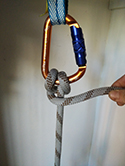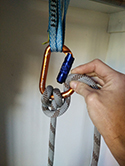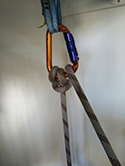It’s a clear Spring afternoon. Warmer than you expected, especially after the terrifying move you just pulled off. But you managed to stick it, and with clammy hands that are a little bit shaky you reach the top of pitch 4, build a quick anchor and shout “In hard!”.
Leaving the rope until your second is ready you reach around, take your ATC off your harness, and
Ding … ding … ding ding …
“Below” You shout, immediately followed by “Shit!”.
Most of us have been in this situation before. And it’s one of several reasons that everyone who works or plays on rope should know the Münter Hitch and its big brother the Super Münter (aka Monster Münter).
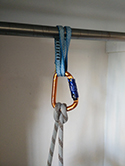

This fabulous little hitch can be used to belay a climber, as a progress capture in a haul system, to abseil, to lower a load (think rescue or recovery), on single or double rope, and can be comfortably used to hold a load up to about 150kg. It inverts on the carabiner, so you can use either strand as the load (or haul) strand and it automatically adjusts. The down side is that it twists the rope, so it’s not time to just toss your ATC in the bin I’m afraid.
All you need to be able to use it is a carabiner - preferably a HMS shape. This actually stands for HalbMastwurf Sicherung, which means ‘Münter Hitch belay’ in German. HMS carabiners exist specifically to be used with Münter hitches. Another fun fact, the German word HalbMastwurf above means ‘half clove hitch’, and that’s exactly what the Münter hitch is - A clove hitch cut in half lengthways.
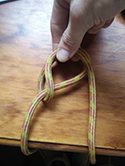
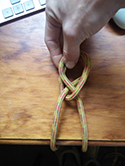
I’ve come across dozens of different ways to tie a Münter hitch. Most of them involve complicated sequences of forming loops and pretending you’re holding a book. Forget all that. Just take your rope and make a loop. Doesn’t matter which way around it is, just any old loop.
Now take one of the lines coming out of the loop - again, it doesn’t matter which one - and fold it over the other length of rope and back onto itself.
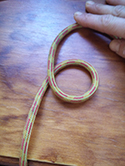
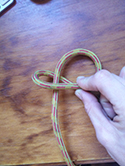

Finally, take your carabiner and attach it to whichever two sections of rope are running next to each other.
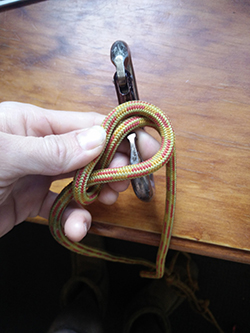
Check that it’s tied correctly by pulling each leg in turn and checking that the knot inverts and pays out in both directions, and you’re done. Use as you would any friction device except, where most friction devices use “thumb up your bum” (rope pulled away from the carabiner back toward the abseiler or anchor) as the position with the highest friction, with a Münter hitch this is the position with the lowest friction. The most friction is achieved when the tail is parallel with the loaded rope. Best practice is to have the tail on the spine side of the carabiner rather than the gate side to avoid cross-loading and potentially opening the gate on your (even tri-lock) carabiner.
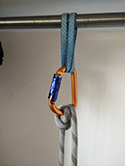
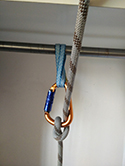
The most effective way to lock the hitch in place so you can go hands-free or leave it unattended is with a slipped half-hitch and overhand. This combination is such a ubiquitous method for locking Münter hitches that it’s also called a Münter Mule.
First, form a bight of rope from the tail. Wrap it around the loaded rope and then through the loop this forms. This is your slipped half hitch. You can adjust the size of the bight now so it’s big enough to tie the overhand. Give yourself a nice, big bight before continuing.
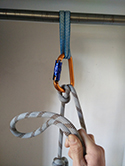
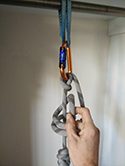
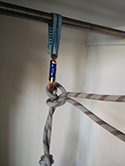
Finally, wrap the bight around the loaded rope and back through itself as shown below. You want the bight tied from outside in and it should run more or less parallel with the loaded rope. If your bight pokes from the inside out, or points off to the side, you’ve probably tied a second half hitch rather than an overhand knot. You can try again, or just tie a third half hitch and call it safe.
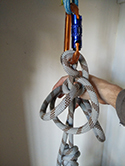
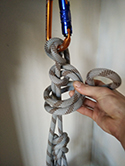
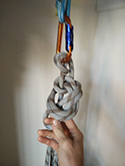
The finished product should be tidy and compact. To lower the rope undo the overhand knot, shorten the bight on the slipped half hitch and then, while holding tension on the tail of the rope loosen the half hitch and slowly untie it, remembering that you’re now carrying whatever’s attached to the other end of the Münter.
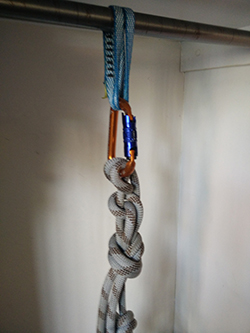
If you’ve got a big load - or a long drop - you can use a Monster Münter (aka Super Münter). This bad boy can easily be used for a 300kg load, and the second twist it adds to the rope cancels out the original twist, so it won’t twist your rope at all. Hold the tail so that it forms a second loop around the loaded rope and clip the tail through the carabiner so that the new loop is pulled into the loaded rope when under tension.
